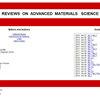Grinding force model for ultrasonic assisted grinding of γ-TiAl intermetallic compounds and experimental validation
IF 3.6
4区 材料科学
Q2 MATERIALS SCIENCE, MULTIDISCIPLINARY
引用次数: 0
Abstract
The introduction of ultrasonic vibration in the grinding process of γ-TiAl intermetallic compounds can significantly reduce its processing difficulty. It is of great significance to understand the grinding mechanism of γ-TiAl intermetallic compounds and improve the processing efficiency by studying the mechanism of ordinary grinding of abrasive grains. Based on this, this study proposes a grinding force prediction model based on single-grain ultrasonic assisted grinding (UAG) chip formation mechanism. First, the prediction model of grinding force is established based on the chip formation mechanism of abrasive sliding ordinary grinding and the theory of ultrasonic assisted machining, considering the plastic deformation and shear effect in the process of material processing. Second, the UAG experiment of γ-TiAl intermetallic compounds was carried out by using diamond grinding wheel, and the unknown coefficient in the model was determined. Finally, the predicted values and experimental values of grinding force under different parameters were compared to verify the rationality of the model. It was found that the maximum deviation between the predicted value of tangential force and the actual value is 23%, and the maximum deviation between the predicted value of normal force and the actual value is 21.7%. In addition, by changing the relevant parameters, the model can predict the grinding force of different metal materials under different processing parameters, which is helpful for optimizing the UAG parameters and improving the processing efficiency.γ-TiAl 金属间化合物超声波辅助磨削的磨削力模型及实验验证
在γ-TiAl 金属间化合物的研磨过程中引入超声波振动,可大大降低其加工难度。通过研究磨粒的普通磨削机理,了解γ-TiAl 金属间化合物的磨削机理,提高加工效率具有重要意义。基于此,本研究提出了基于单晶粒超声辅助磨削(UAG)切屑形成机理的磨削力预测模型。首先,基于磨粒滑动普通磨削的切屑形成机理和超声辅助加工理论,考虑材料加工过程中的塑性变形和剪切效应,建立磨削力预测模型。其次,利用金刚石砂轮对γ-TiAl 金属间化合物进行了 UAG 实验,确定了模型中的未知系数。最后,比较了不同参数下磨削力的预测值和实验值,验证了模型的合理性。结果发现,切向力预测值与实际值的最大偏差为 23%,法向力预测值与实际值的最大偏差为 21.7%。此外,通过改变相关参数,该模型可以预测不同加工参数下不同金属材料的磨削力,有利于优化 UAG 参数,提高加工效率。
本文章由计算机程序翻译,如有差异,请以英文原文为准。
求助全文
约1分钟内获得全文
求助全文
来源期刊

Reviews on Advanced Materials Science
工程技术-材料科学:综合
CiteScore
5.10
自引率
11.10%
发文量
43
审稿时长
3.5 months
期刊介绍:
Reviews on Advanced Materials Science is a fully peer-reviewed, open access, electronic journal that publishes significant, original and relevant works in the area of theoretical and experimental studies of advanced materials. The journal provides the readers with free, instant, and permanent access to all content worldwide; and the authors with extensive promotion of published articles, long-time preservation, language-correction services, no space constraints and immediate publication.
Reviews on Advanced Materials Science is listed inter alia by Clarivate Analytics (formerly Thomson Reuters) - Current Contents/Physical, Chemical, and Earth Sciences (CC/PC&ES), JCR and SCIE. Our standard policy requires each paper to be reviewed by at least two Referees and the peer-review process is single-blind.
 求助内容:
求助内容: 应助结果提醒方式:
应助结果提醒方式:


